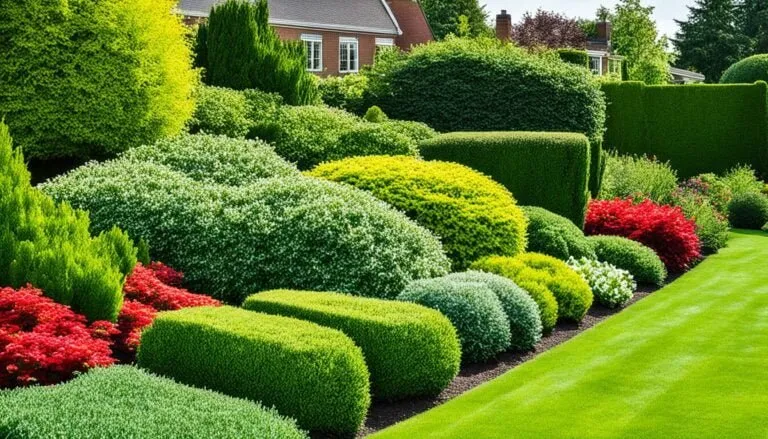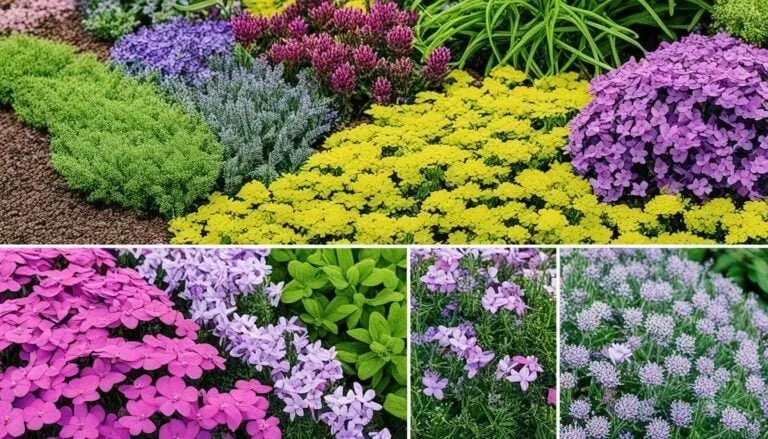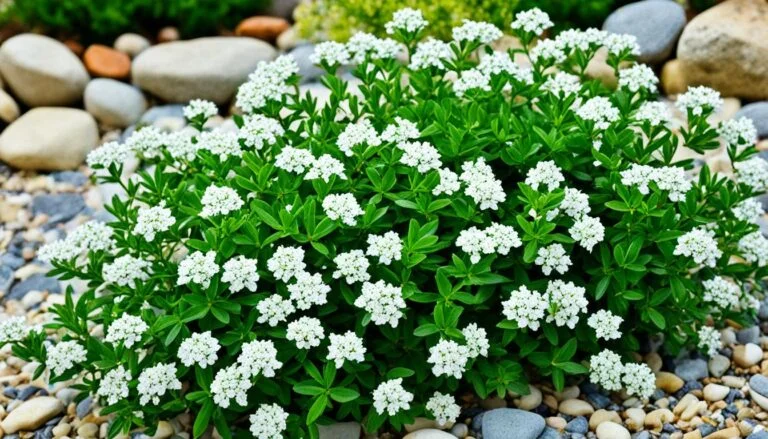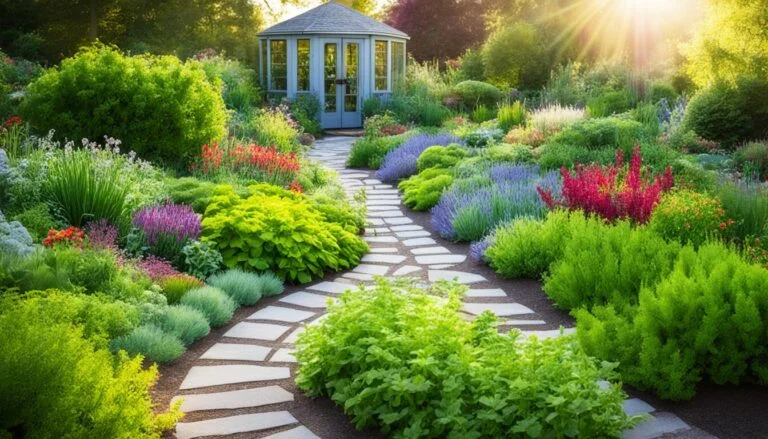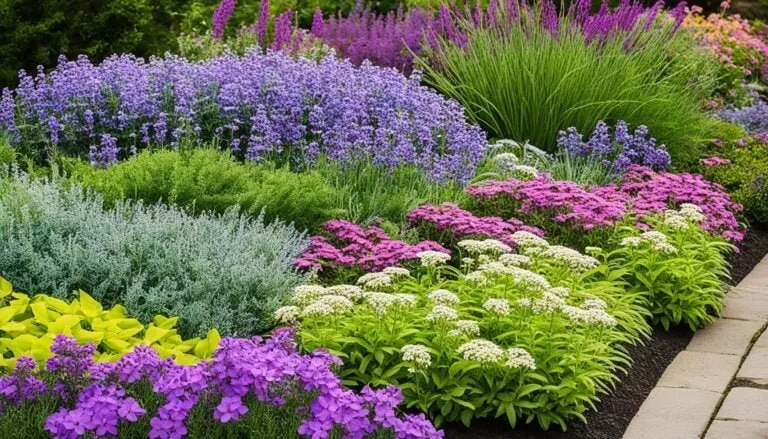Choosing the right perennial border plants is the first step to a beautiful garden. These low plants blend colors and textures in your garden border. They help define spaces, look beautiful, and help butterflies as they are drought tolerant.
This gardening guide is here to help. It will show you which low plants are good for different conditions. Plants like Sedum (Stonecrop), Thymus serpyllum (Creeping Thyme), and Geranium sanguineum (Bloody Cranesbill) can make your garden look better and work well. For more help, check out other guides on these topics.
Key Takeaways
- Low growing border plants blend vibrant colors and diverse textures for an artful garden border.
- They offer practical benefits such as drought tolerance and attractiveness to pollinators.
- Choosing the right plants for your garden conditions is essential for maintaining a thriving border.
- Recommended plants include Sedum (Stonecrop), Thymus serpyllum (Creeping Thyme), and Geranium sanguineum (Bloody Cranesbill).
- Explore additional guides for more gardening tips and insights.
Introduction to Low Growing Border Plants
Low growing plants are key in garden design. They don’t just look good. They also help with keeping weeds away and keeping the soil in place. You can choose from tough herbaceous plants to grasses, succulents, and flowering perennials. This makes them great for garden borders.
Choosing ground cover plants and sun-loving border plants is all about the garden’s sunlight, soil, and water needs. Using plants that don’t need a lot of water can save you time. Mixing plants of different heights makes the border look better. Low plants like thyme and sedum need little care but are strong and beautiful.
It’s helpful to group plants into bulbs, shrubs, perennials, and ground covers. This helps you make sure your border looks good all year. Each plant prefers different light, like full sun or deep shade.
To make your garden look balanced and pretty, mix plants that bloom at different times with those that stay green all year. This not only keeps your garden interesting but helps bees and butterflies too. Knowing how to take care of plants, like how to prune them and keep the soil healthy, will help them grow well and look great.
In the next parts, we will focus on specific plants and ways to make a beautiful border that’s good for the environment. Keep reading to learn about the top sun-loving border plants and more.
Top Varieties of Low Growing Border Plants
Choosing the right low growing border plants can make your garden look better. It can also make it easier to maintain. Here, we look at top varieties known for resilience, beauty, and low need for care. Our picks include drought-tolerant, flowering, and easy-care plants in one handy guide.
Sedum (Stonecrop)
Sedum, or Stonecrop, is among the best for dry conditions. Its leaves in various colors and shapes add texture and life to borders. Perfect for zones 3-9, it needs little water, great for dry climates. Sedum’s pretty flowers also help pollinators thrive.
Thymus serpyllum (Creeping Thyme)
Creeping Thyme is for those wanting hassle-free plants. It can handle being walked on and looks great between stones. For zones 4-9, it smells lovely when crushed and is loved by bees and butterflies. This means it’s both useful and beautiful.
Geranium sanguineum (Bloody Cranesbill)
Bloody Cranesbill flowers for a long time, from late spring to early summer. It stands at 1-2 feet tall, great for zones 3-8. The leaves turn red in fall, keeping the area pretty even after blooming season. Plus, it’s easy to care for.
Adding these plants to your garden makes it not just pretty but also low-maintenance and drought-tolerant.
Why Choose Low Growing Border Plants?
Many gardening fans love low growing border plants for several reasons. They are not just beautiful but also easy to care for. These plants help make your garden look great with little effort.
Easy Garden Management
Low growing border plants, like Geranium sanguineum and Lavandula, make taking care of your garden simple. You won’t need to spend a lot of time trimming or watering them. For example, Geranium sanguineum needs little care and keeps deer away. Lavandula does well with little water and attracts helpful pollinators.
These plants also stop weeds from growing by covering the soil. This makes your garden less work. You can enjoy spending time there without always having to weed.
Enhanced Aesthetic Appeal
Low growing border plants like Stachys byzantina and Nepeta bring lovely textures to your garden edges. They make your garden look bigger and let taller plants catch your eye. Plants such as Heuchera add beautiful color with their evergreen leaves, attracting birds and thriving even in shade.
Because some plants, like Alchemilla mollis and Nepeta, are easy on the eyes and easy to care for, your garden will always look good. For instance, Alchemilla mollis keeps its shape and can withstand dry spells once it’s grown. Nepeta blooms for a long time and is quite a looker, great for less formal garden styles.
So, by picking low growing border plants, you’re choosing a garden that’s easy to keep up and looks great. They make your garden more welcoming, and they are essential for a smart garden layout.
Best Low Growing Border Plants for Different Conditions
Choosing the right low growing border plants is key for your garden’s look and function. For different light levels, dry spots, or covering the ground well, there’s a plant that fits perfectly. Let’s look at some great choices for various garden settings:
Ground Cover Plants
Ground cover plants fill gaps, limit weeds, and keep soil steady. Tiarella cordifolia (Foamflower) shines with its pretty white or pink flowers. It has nice leaves too. Thymus serpyllum (Creeping Thyme) has bold flowers and can handle being walked on. It’s great for paths and around stones. These plants make a beautiful, easy-to-care-for garden bed.
Drought-Tolerant Border Plants
Plants that survive dry spells are important for some gardens. Sedums are good picks. They have unique star flowers in summer and keep water in their leaves. Lavandula (Lavender) smells great, looks good, and brings pollinators. Pair them with Stachys byzantina (Lamb’s Ear) for a soft, deer-proof contrast.
Shade-Tolerant Border Plants
Shaded areas can also be full of color and life. Heuchera (Coral Bells) has bright, year-round leaves that do well in low light. They attract hummingbirds too. Hakonechloa macra (Japanese Forest Grass) sways beautifully in the shade. Its flowing leaves add movement and interest.
Picking plants that like shade, are tough in dry spots, and cover the ground well lets you create an amazing garden. It works in any space.
Design Tips for Garden Borders with Low Growing Border Plants
To make beautiful garden borders, choose low growing plants carefully. Consider the colors, textures, and heights of the plants. This creates a pretty and easy-to-care-for space.
Play with Colors and Textures
Colors and textures add life to your garden. Pair plants like Geranium sanguineum with Stachys byzantina for a lively look. Using plants like Hakonechloa macra with Dianthus adds depth and variety to your garden.
Adding Heuchera can bring in different colors throughout the year. Plants like Sedum add a burst of color with their flowers. This mix makes a garden full of life.
Arrange by Height
It’s key to place plants by their height for a balanced look. For a backdrop, use taller plants such as Nepeta. In the middle, place medium-height plants like Alchemilla mollis. At the front, lower plants like Thymus serpyllum make everything smell good.
| Plant | Feature |
|---|---|
| Geranium sanguineum | Bright magenta flowers, minimal care |
| Stachys byzantina | Velvety, silver foliage, drought-tolerant |
| Hakonechloa macra | Softens hard edges, pairs well with perennials |
| Dianthus | Fragrant flowers, attracts butterflies |
Good selection and order of plants makes your garden beautiful. This creates a space that looks great all year with little work.
Maintenance Advice for Low Growing Border Plants
Keeping low maintenance border plants healthy is easy with a few key steps. These plants need little attention to stay bright and attractive all year. This means your garden stays pretty without much work from you.
Regular Pruning and Deadheading
Pruning and deadheading are important for lush growth and longer blooms. For instance, Geranium sanguineum needs its old blooms removed for new flowers to appear. Also, trimming Sedum helps new, healthy stems grow. Remembering to do these tasks keeps your plants looking great.
Soil Health
Good soil is a must for these plants to grow well. Check your soil and add things to make it better, like compost. Using mulch helps the soil keep in moisture and fight weeds. Don’t forget to water, especially when it’s dry. Even plants that can handle drought need a deep drink every now and then to stay strong.
Following these easy steps will make sure your plants do well, adding lasting beauty with little effort on your part.
Best Border Plants with Seasonal Interest
Choosing the right border plants keeps your garden beautiful all year. Some plants bloom in spring and summer, while others shine in autumn and winter. Here’s a list of the best perennial border plants for each season.
Spring and Summer Bloomers
Nepeta (Catmint) and Geranium Maculatum (Hardy Geranium) are perfect for bright spring and summer. Nepeta attracts pollinators with its blue-purple flowers over an extended period. Hardy Geranium blooms for a long time and stands up well, fitting many garden styles. These are great *perennial border plants*.
Autumn and Winter Interest
In fall and winter, keep your garden look with plants like Sedum and Heuchera. Sedum’s structure remains even after its blooms are gone. Heuchera’s green leaves stay bright, adding color in the cold. These *flowering border plants* are low-care and keep your garden pretty all year.
Planting these *border plants* means a colorful, textured garden all seasons. By choosing plants that bloom at different times, your garden border will always change and surprise. The mix makes your garden’s edge look lively year-round.
Where to Buy the Best Low Growing Border Plants
Looking for the best low growing border plants means checking out physical stores and online shops. A good supplier means you get plants perfect for your garden. Here’s where we suggest you look:
Local nurseries are great because they give advice and have plants that suit your area. You can also see the plants up close before buying them.
Want to shop from your couch? Many online stores sell flowering border plants and ground covers. Places like Proven Winners, Burpee, and High Country Gardens offer top-notch plants and useful care tips.
For flowers, pick ones with strong looks and no sickness. They should have lively leaves and strong roots. These tricks help them take root fast once they are in your garden.
If you’re into low-maintenance, try plants like Creeping Thyme and Sedum. They don’t need much water and are good at keeping weeds down.
Still wondering what to buy? Look in gardening books or talk to gardeners online. They can share what worked for them, helping you choose well.
Remember, where you buy matters as much as what you buy. Go with trusted sellers to fill your garden with life and color.
| Plant | Characteristics | Suppliers |
|---|---|---|
| Sedum | Drought-tolerant, attracts butterflies | High Country Gardens |
| Creeping Thyme | Resilient to foot traffic, loved by bees | Burpee |
| Bloody Cranesbill | Prolonged blooming, deer-resistant | Proven Winners |
Conclusion
Low growing border plants can make your garden better in many ways. They make the garden look pretty and need less care. And they help nature thrive. There are many kinds to pick from. Some, like Lavender and Yarrow, can handle little water. Others, like Garden Phlox, love the sun. So, there’s a perfect plant for every garden. You just need to choose wisely.
For gardens that face west, consider plants like Verbena bonariensis and Garden Phlox. They soak up the sun well. Plus, they bring color and height to your borders. This makes your garden more interesting.
Picking easy-care border plants such as Daylilies and Hardy Geraniums is smart. They keep your garden looking great without a lot of work. Hardy Geraniums flower a lot, from spring to fall. Daylilies do well in many light conditions. And mixing various plant types and colors is fun. It makes your garden more dynamic.
Enjoy working on your garden with these simple plants. They can make your garden lovely all year. Follow what we’ve shared in this advice to make your garden a beautiful place. For more help and ideas, check out the Meadowlark Journal.





